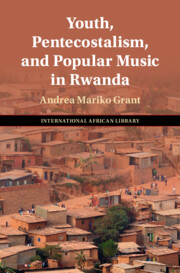Refine search
Actions for selected content:
154 results
The Deceptive Allure of Luxury Tourism: The Political Economy of Tourism Strategies in Mauritius, Botswana, and Rwanda
-
- Journal:
- African Studies Review , First View
- Published online by Cambridge University Press:
- 13 October 2025, pp. 1-26
-
- Article
-
- You have access
- Open access
- HTML
- Export citation
2 - Justice and Coercion in Rwanda
-
- Book:
- Escaping Justice
- Published online:
- 19 September 2025
- Print publication:
- 09 October 2025, pp 53-88
-
- Chapter
-
- You have access
- Open access
- HTML
- Export citation
Introduction
-
- Book:
- Escaping Justice
- Published online:
- 19 September 2025
- Print publication:
- 09 October 2025, pp 1-21
-
- Chapter
-
- You have access
- Open access
- HTML
- Export citation

Escaping Justice
- Impunity for State Crimes in the Age of Accountability
-
- Published online:
- 19 September 2025
- Print publication:
- 09 October 2025
-
- Book
-
- You have access
- Open access
- Export citation
(Don’t) Visit Rwanda: Rwanda’s Sportswashing and Its Western Facilitators
-
- Journal:
- African Studies Review / Volume 68 / Issue 2 / June 2025
- Published online by Cambridge University Press:
- 21 July 2025, pp. 315-337
-
- Article
-
- You have access
- Open access
- HTML
- Export citation

Fractured Pasts in Lake Kivu’s Borderlands
- Conflicts, Connections and Mobility in Central Africa
-
- Published online:
- 17 July 2025
- Print publication:
- 31 July 2025
4 - Implementing Fee-Free Education in Rwanda
-
-
- Book:
- Politics and Knowledge Shaping Educational Reform
- Published online:
- 06 February 2025
- Print publication:
- 13 February 2025, pp 43-57
-
- Chapter
- Export citation
Trajectorial dynamics of English in Rwanda: Non-postcolonial English in an Outer Circle country
-
- Journal:
- English Today / Volume 41 / Issue 1 / March 2025
- Published online by Cambridge University Press:
- 30 January 2025, pp. 28-34
- Print publication:
- March 2025
-
- Article
-
- You have access
- Open access
- HTML
- Export citation
Political Institutions and Perceived Political Representation Before, During, and After Identity-based Conflict: Comparing Views from Rwandan and Burundian Citizens
-
- Journal:
- African Studies Review / Volume 67 / Issue 4 / December 2024
- Published online by Cambridge University Press:
- 23 January 2025, pp. 837-862
-
- Article
-
- You have access
- Open access
- HTML
- Export citation
1 - Of Hearts, Visions, and Pentecostal Subjects
- from Part I - Urban Youth and Pentecostal Worlds
-
- Book:
- Youth, Pentecostalism, and Popular Music in Rwanda
- Published online:
- 19 December 2024
- Print publication:
- 02 January 2025, pp 35-65
-
- Chapter
- Export citation
3 - Leaving a Legacy: Pentecostal Women and Timework
- from Part I - Urban Youth and Pentecostal Worlds
-
- Book:
- Youth, Pentecostalism, and Popular Music in Rwanda
- Published online:
- 19 December 2024
- Print publication:
- 02 January 2025, pp 93-120
-
- Chapter
- Export citation
2 - Who Are the ‘True’ Sons of God? Ubwenge and Pentecostal Ethics
- from Part I - Urban Youth and Pentecostal Worlds
-
- Book:
- Youth, Pentecostalism, and Popular Music in Rwanda
- Published online:
- 19 December 2024
- Print publication:
- 02 January 2025, pp 66-92
-
- Chapter
- Export citation
8 - The Making of a ‘Superstar’
- from Part II - Urban Youth and Musical Worlds
-
- Book:
- Youth, Pentecostalism, and Popular Music in Rwanda
- Published online:
- 19 December 2024
- Print publication:
- 02 January 2025, pp 244-266
-
- Chapter
- Export citation
7 - Singing Life: Hip Hop in the City
- from Part II - Urban Youth and Musical Worlds
-
- Book:
- Youth, Pentecostalism, and Popular Music in Rwanda
- Published online:
- 19 December 2024
- Print publication:
- 02 January 2025, pp 211-243
-
- Chapter
- Export citation
4 - Rwanda Shima Imana: The Politics of Thanksgiving
- from Part I - Urban Youth and Pentecostal Worlds
-
- Book:
- Youth, Pentecostalism, and Popular Music in Rwanda
- Published online:
- 19 December 2024
- Print publication:
- 02 January 2025, pp 121-148
-
- Chapter
- Export citation
Introduction
-
- Book:
- Youth, Pentecostalism, and Popular Music in Rwanda
- Published online:
- 19 December 2024
- Print publication:
- 02 January 2025, pp 1-32
-
- Chapter
- Export citation
5 - Pentecostal Sounds and Voice
- from Part I - Urban Youth and Pentecostal Worlds
-
- Book:
- Youth, Pentecostalism, and Popular Music in Rwanda
- Published online:
- 19 December 2024
- Print publication:
- 02 January 2025, pp 149-176
-
- Chapter
- Export citation
Conclusion
-
- Book:
- Youth, Pentecostalism, and Popular Music in Rwanda
- Published online:
- 19 December 2024
- Print publication:
- 02 January 2025, pp 267-277
-
- Chapter
- Export citation

Youth, Pentecostalism, and Popular Music in Rwanda
-
- Published online:
- 19 December 2024
- Print publication:
- 02 January 2025
Chapter 7 - Hazard
-
- Book:
- Cultural Stereotype and Its Hazards
- Published online:
- 21 November 2024
- Print publication:
- 28 November 2024, pp 218-240
-
- Chapter
- Export citation
